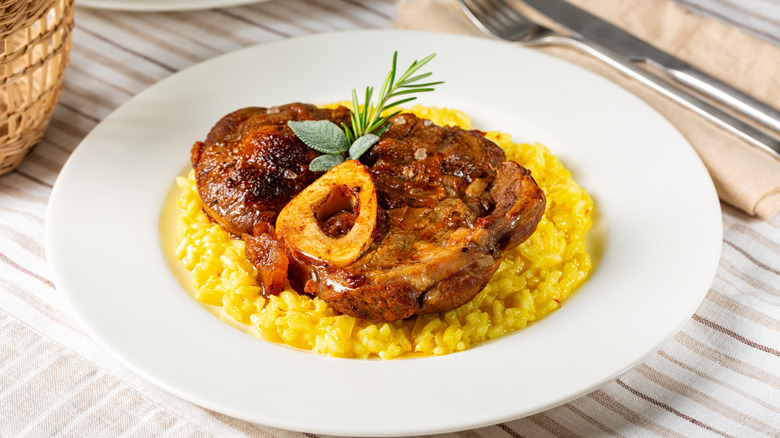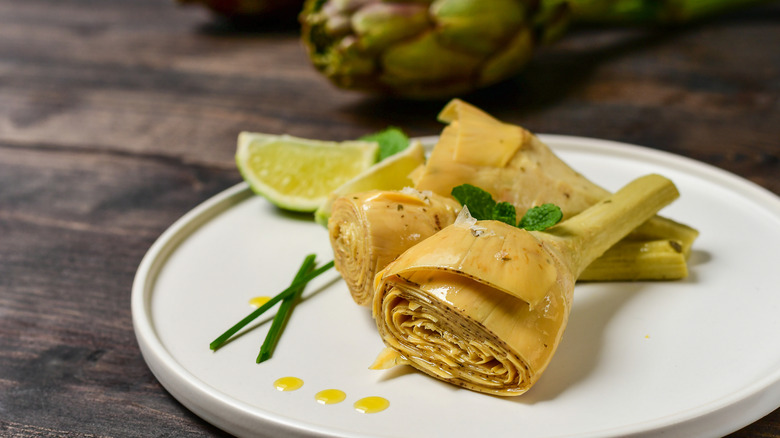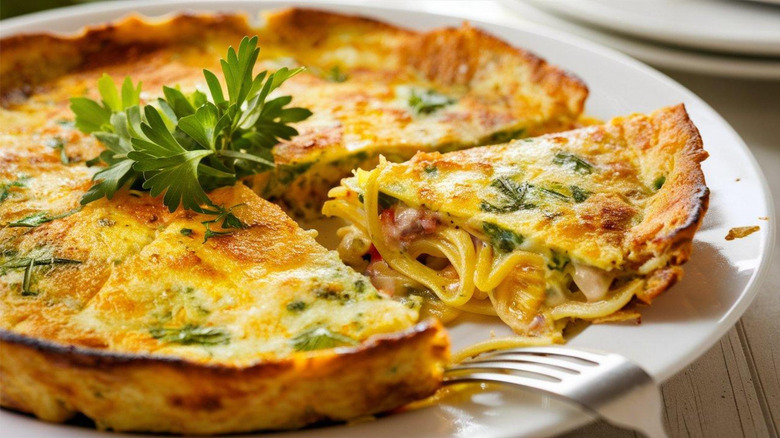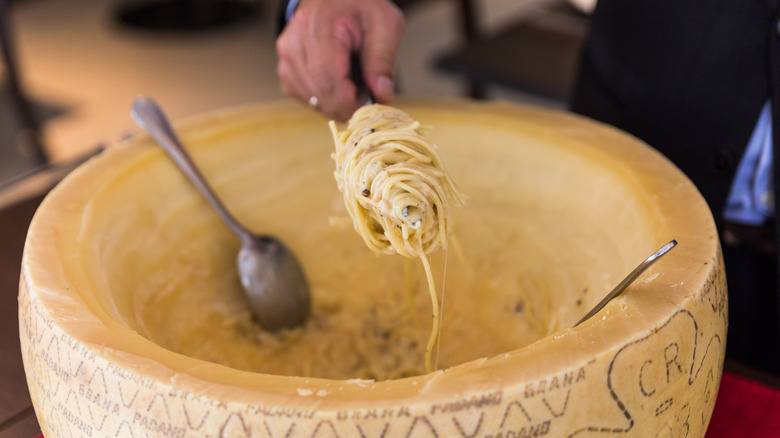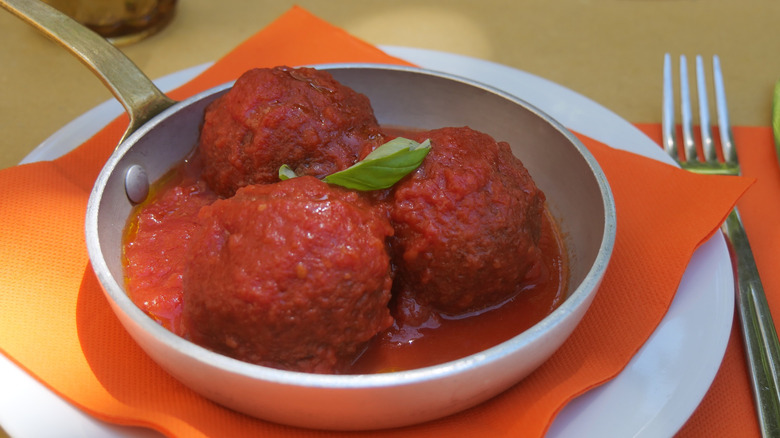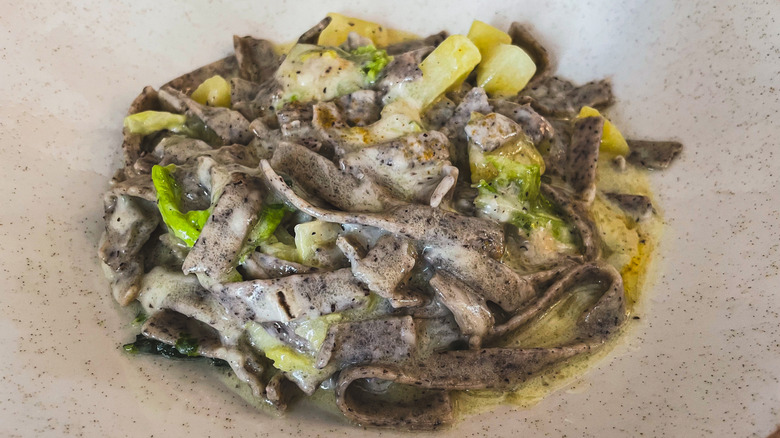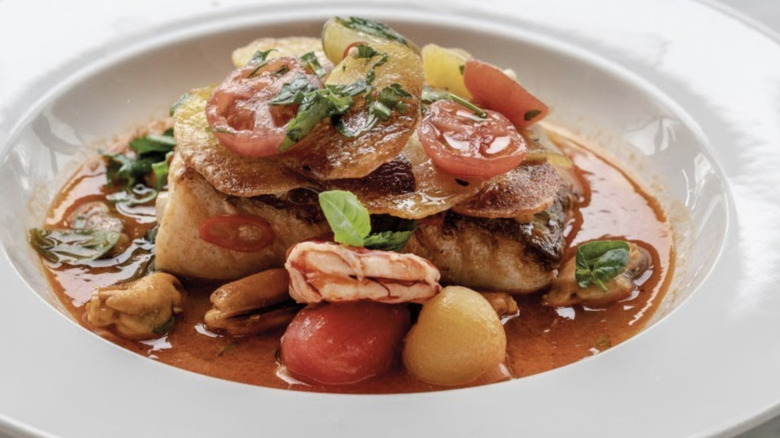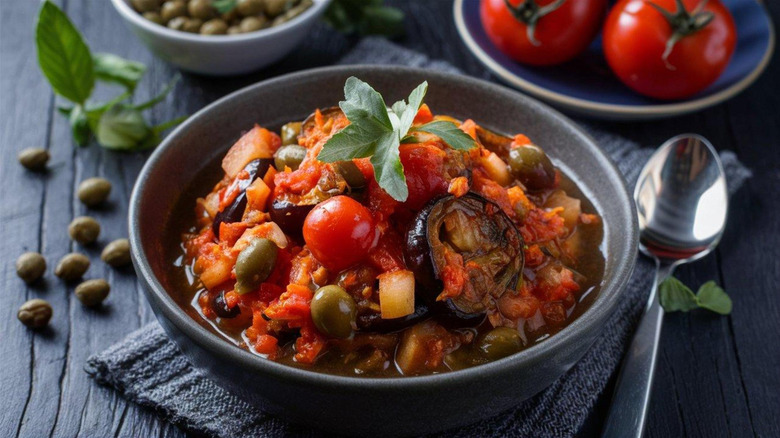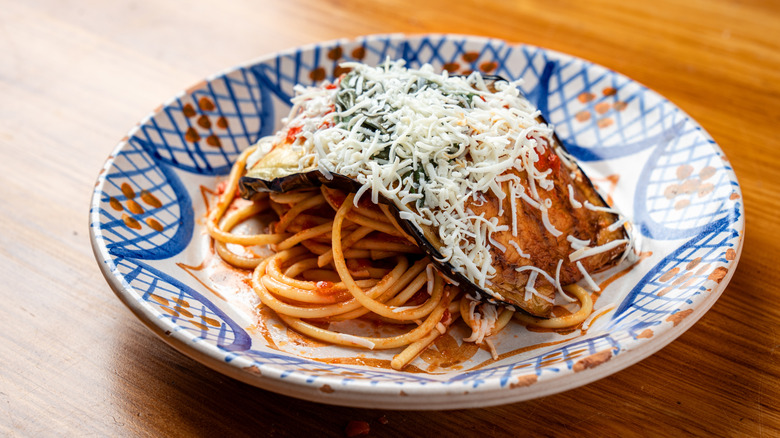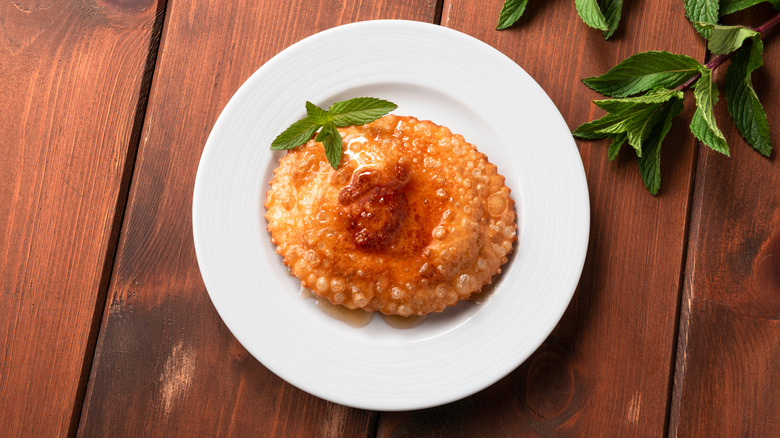Regional Italian Foods Chefs Think Everyone Should Try
On average, most Americans will reach for a slice of pizza at least three times a month. The dish is a classic comfort food, loved for its cheesy, saucy topping and satisfying crust. It is one of Italy's most famous culinary exports, rivaled by spaghetti, of course, which is a midweek classic for many US families. But beyond these favorites, Italian cuisine is rich and varied. Italy is divided into 20 different regions, and each has an individual and unique culinary scene. "Italy has very pronounced regional food," Italian chef and cookbook author Danilo Cortellini explains. "Every region has its own traditions and specialty — actually, every town has a way of doing things."
Bologna, for example, the capital of Emilia-Romagna, is famous for meat ragù, while Sicilian cuisine is known for couscous, due to Sicily's proximity to North Africa (where the semolina-based dish originated). More broadly speaking, northern regions cook with butter, while the south has a love affair with olive oil. "The beauty of Italian cuisine is that it's very broad," explains Sardinian chef Francesco Mattana. "You can find naturally vegan dishes, amazing slow-cooked meat dishes, and fresh fish."
If you're feeling inspired to step beyond your go-to margarita pizza or penne alla vodka, we've consulted the experts and gathered a few must-try regional Italian dishes below.
Risotto alla Milanese, Lombardy
If northern Italy is famous for one dish, it's risotto. Made with high-starch rice (usually of the arborio variety) and stock, alongside ingredients like butter, saffron, and Parmesan, the dish is creamy and indulgent. In Milan, the north's biggest city and Lombardy's capital, risotto alla Milanese — a variety of risotto cooked with yellow saffron-infused rice and bone marrow often served with osso buco (braised veal shank) — is the star of most menus, says Bernardo Paladini of the Miami Italian restaurant Torno Subito. "It is both deep in flavor and a long-standing dish that represents the city and its history," he explains.
Legend has it that risotto alla Milanese dates all the way back to the 16th century, when a glassmaker invented it for his daughter's wedding at Milan's Cathedral. However, there is no concrete proof of this theory, and risotto alla Milanese wasn't featured in written records until the 1800s. Regardless of when it was invented, the dish resonates strongly with many Milanese people.
Francesco Mattana agrees that risotto alla Milanese (which can be made vegetarian without the bone marrow or the ossobuco) is a must-try. He describes it as "incredibly rich and comforting" with a "beautiful aroma." Danilo Cortellini adds that the dish is "lovely" with gremolata, a popular Italian condiment made with parsley, lemon zest, and garlic. On the topic of risotto, Cortellini also recommends Piedmont's truffle risotto (the northern Italian region borders France in the west) and zucca risotto in Veneto (the northeastern home of the popular city and lagoon of Venice).
Roman marinated artichokes, Lazio
If you're a fan of carbonara, you're already a fan of Roman cuisine. It is one of the city's four signature pasta dishes (alongside cacio e pepe, bucatini all'Amatriciana, and pasta alla Gricia). But outside of the famous four, Italy's bustling capital is bursting with flavor-packed, traditional cuisine. "Rome is a city that offers so much," says Tommaso Mazzanti of Florentine sandwich shop chain All'Antico Vinaio. "As does the entire Lazio region. Many other Roman products deserve glory." In fact, one particular standout dish doesn't involve pasta at all: Roman marinated artichokes.
Marinated artichokes (or carciofi alla Romana, as they are known in Italy) are simple yet full of flavor. The dish simply consists of artichokes, which have been marinated in garlic and herbs before being slowly fried in white wine. The dish has a rich history with Rome's Jewish population — it was first created by housewives in the city's ghettos back in the 16th century, when Jewish people lived segregated from the Catholic population.
Carciofi alla Romana is still loved across the city today. "When artichoke season arrives, they're everywhere," says Bernardo Paladini. "Piled high in markets and featured on nearly every restaurant menu in some shape or form." Danilo Cortellini adds: "[The Jewish people] have elevated carciofi alla Romana to perfection. This artichoke, it's fried twice so it opens up and looks like a flower. A crispy, delicious flower."
Frittata de pasta, Campania
It's no surprise that Campania is one of the "best eating regions in Italy," according to Tommaso Mazzanti. It is, after all, the home of Naples, the city that gave the world one of its most beloved dishes: Pizza. But another "wonderful" Neapolitan dish that deserves more hype is frittata de pasta, says Bernardo Paladini.
Frittata de pasta is basically a spaghetti omelette made with leftovers, which means it was likely born from a desire to reduce food waste. Naples is a historically poor city, so over the centuries, the population has had to become skilled at making tasty food out of very few ingredients. "Frittata de pasta is seasoned with eggs, cheeses like mozzarella, and other seasonal ingredients of your choosing," explains Paladini. "It is a common street food in Naples, served in a variety of traditional trattorias."
Paladini notes that the low-waste approach to food seen in the creation of frittata de pasta had a profound influence on him as a chef. At Torno Subito, there are many low-waste and zero-waste dishes on the menu. "It's magical to bring new life to ingredients that would otherwise be thrown away," he says. "[This is] perfectly represented by Naples' frittata."
Pasta alla ruota, Emilia-Romagna
Another great example of Italians embracing low-waste cooking is pasta alla ruota. The simple dish consists of pasta cooked inside a hollowed-out Parmesan cheese wheel to create an ultra-creamy, ultra-cheesy dish with very little waste. The dish was pioneered by Massimo Bottura, the founder of Torno Subito (where Bernardo Paladini is executive chef), who wanted to help save Emilia-Romagna's parmesan cheese wheels after they were damaged in a 2012 earthquake.
It was a success story then, and it's still a popular dish now. In fact, pasta alla ruota has become a viral social media hit. Many videos of TikTok creators making the dish have hundreds of thousands of views. Outside of the internet, the dish is also showing up on menus, too. "Pasta alla ruota is now used at restaurants around the world," explains Paladini. "It serves as a perfect example of Bottura's philosophy of finding creative ways to use ingredients that would otherwise go to waste."
Pallotte cacio, Abruzzo
It wasn't just Neopolitans who had to make do with very little ingredients. In southern Abruzzo, another historically poor region of Italy, Italians were skilled at "cucina povera," which translates to "cooking of the poor." This type of cooking involves small amounts of inexpensive ingredients, but the results are filled with flavor. "Ingredients were squeezed to the limit," explains Danilo Cortellini. "People were smarter because they had to be."
Pallotte cacio is one example of a hearty dish born out of Abruzzese cucina povera. "It is essentially a meatball without any meat," adds Cortellini. "It was traditionally made with cheese, perhaps cheese crust, eggs and stale bread. They are mixed together to look like meatballs and then served in a rich tomato sauce."
Cortellini believes that, in general, Abruzzese cuisine — which includes not just pallotte cacio but also arrosticini (lamb skewers), pasta e fagioli (pasta and beans), brodetto di pesce (fish stew) — deserves more time in the spotlight. "From the seafront up to the mountains, there's a big variety [in this region]," he says.
Pizzoccheri della Valtellina, Lombardy
In northern Lombardy, on the border of Switzerland, sits Valtellina, a valley famous for its stunning scenery (which you can view from the world-famous Bernina Express train), interesting history, and, of course — like much of Italy — its food. The most famous dish from this part of Italy is pizzoccheri, which is tagliatelle pasta cooked with pasta, cabbage, potatoes, and plenty of butter.
But the pasta used to make pizzoccheri isn't your standard tagliatelle, explains Danilo Cortellini. "It's so unique because it's made with buckwheat instead of regular flour, so it's a totally different taste," he says. "It is served with a lot of local cheese, like Fontina." The cheese is also unique; it is creamy, earthy, and always made with unpasteurized milk from local cows.
Another must-try dish from Valtellina and Lombardy in general is polenta, a yellow porridge made with ground cornmeal. "If I had to recommend a traditional dish from Northern Italy, I would say polenta with bolognese sauce or at least a meat sauce," says Tommaso Mazzanti. "I remember as a child, when my parents prepared it, you could feel the atmosphere of Northern Italy."
Baccalà guazzetto, Lazio
Guazzetto, which features a rich, thick tomato-based sauce, is a popular dish across Italy. It's usually served with seafood, although it can also be made with beans or meat. Traditionally, though, this dish is limited to the flavors of the ocean. In Rome, in Lazio, guazzetto with salted cod is a firm favorite. The Roman version of the dish also features raisins, and is enjoyed for its mix of sweet, savory, and sour flavors.
But guazzetto can feature anything from prawns to clams to baby octopus – the ingredients vary and largely depend on what's available in each region. "In Italy, you will find so many varieties of guazzetto, because every region that has a seafront will do it in a different way," says Danilo Cortellini. "I like it alot because you will find the best expression of the local seafood."
Guazzetto is one of many Italian seafood dishes. Other favorites include spaghetti with clams (known in Italian as vongole) and fried seafood in Campania. "You cannot go to Campania and not have a selection of fried seafood or the famous spaghetti a vongole," adds Cortellini. For Tommaso Mazzanti, another seafood favorite from Italy's southern coastal regions is spaghetti ai ricci di mare (pasta with sea urchins). "It's a dish that makes me dream of beaches with rocks," he says. "[It's] a magic of flavors."
Caponata, Sicily
Caponata, a rich, sweet, slightly sour stew made with vinegar and sugar, is another dish that was born out of cucina povera, but has held its ground over the years as a flavor-packed favorite. The name derives from the Sicilian term for a local species of fish called lampuga (known more widely by its Hawaiian name, mahi-mahi), but despite this, caponata is actually totally fish-free. Real lampuga was too expensive, so Sicilians replaced it with eggplant.
Alongside eggplant, caponata features many different ingredients, including tomatoes, celery, olives, capers, and peppers. Occasionally, raisins and nuts are added, too, explains Francesco Mattana. "There are different versions of this recipe around the island but essentially it is the perfect combination of vegetables cooked in agrodolce (sweet and sour)," he says.
Caponata is a great example of a naturally plant-based Italian dish. It tastes "amazing with couscous," notes Mattana, but if you want animal protein, the chef recommends serving it with burrata cheese, roast chicken, or oven-baked fish.
Pizzetta da passeggio cagliaritana, Sardinia
Italy has a thriving street food scene. In Sicily, for example, arancini (deep-fried risotto balls) are a staple, and in Abruzzo, the aforementioned arrosticini is usually cooked and sold on the street. "Every region of Italy, together with its cities, boasts a true street food culture that blends tradition and modernity," says Tommaso Mazzanti. But, as Danilo Cortellini declares, of course, in Italy "pizza is the best street food of all."
There are many, many different types of street food pizza, but on the island of Sardinia, pizzetta da passeggio cagliaritana (also known as Cagliari pizza, because it's from the town of Cagliari) is the go-to for many locals. "I grew up with this," says Francesco Mattana. "It's the perfect pizza to have on the go." He explains that the dough is stretched so it's thin and crispy, slowly baked with tomato sauce and mozzarella, and then cut and folded to look like a wallet. This adds to the crispy texture, but also makes it easy to eat while you're on the move.
Another notable type of tasty street pizza is Rome's pizza al taglio, which Bernardo Paladini describes as the "classic slice." He explains, "It's served in rectangular pieces. You choose your portion size based on how hungry you are and pay by weight."
Pasta alla norma, Sicily
Similar to caponata, pasta alla norma revolves around very simple vegetable-based ingredients: Eggplant, tomato, and garlic. The eggplants are fried, before they are mixed with pasta, plenty of olive oil, of course (as is the way in the south), basil, and salted ricotta cheese.
Francesco Mattana assures that even though it all sounds very simple, the resulting flavors make this pasta dish a must try in Sicily. "If you've never heard of pasta alla norma before, you are missing out on probably one of the best pasta dishes ever," he says. "I know it sounds very simple, but it's packed full of flavor."
While we're on the topic of Sicily, another must-try dish of the region is cannoli. The sweet fried pastry, filled with creamy ricotta, is a popular street food on the island. "I can't talk about Sicily without mentioning its desserts, like cannoli and granita with brioche," says Bernardo Paladini. "In Italy, we have a specific word for the balance of sweet and sour, agrodolce, and it's this harmony that makes Sicilian desserts so exceptional."
Rum babà, Campania
Another Italian dessert that deserves a shout out is rum babà, which hails from Campania and is particularly loved in Naples. The dessert is a type of cake, which, as the name suggests, is soaked in rum syrup. It also gets a zesty sweetness from ingredients like sugar, lemon, and oranges. The dessert is a favorite of Bernardo Paladini's, who says it's "perfect to enjoy with a coffee."
Other sweet treats that deserve more recognition include Tuscany's torta della nonna, says Tommaso Mazzanti, which translates to "grandma's custard pie" and features a pastry pie with a sweet citrus custard filling. Bongo, which features small balls of choux pastry, chocolate, and cream and hails from the city of Florence, is another. "It's also known as profiteroles," he notes. "It deserves more global attention."
All of that said, many Italians agree that globally-renowned tiramisu is hard to resist. "I would choose it over a thousand other desserts," says Mazzanti. Danilo Cortellini adds "it's my favorite, too. People cannot be blamed because they love it."
Seadas, Sardinia
Finally, if you're on the island of Sardinia and you're in the mood for a sweet treat, seadas is a must, says Francesco Mattana. "It's a large deep-fried raviolo, filled with pecorino cheese," he explains. It doesn't sound like a dessert initially, but when drizzled with honey and orange zest, it becomes a harmonious mix of sweet and savory flavors. "It's one of my favorites," adds Mattana. "It's also a meal on its own so keep this in mind when ordering it."
He might be biased, but Sardinia native Mattana believes that this region's culinary scene is one of the most underrated in the whole of Italy. "We have been influenced by a wide range of cultures including Spanish and French in the very north and African and Arabic in the south," he says. "This has given us a number of different dishes that are familiar to everyone but with a distinct Sardinian-Italian touch."
Sardinia is also one of the healthiest regions in the world. In fact, it is classed as a Blue Zone, which is a geographic area of the world where, some research suggests, people live longer than others. This could be because of the island's emphasis on fresh, seasonal, ingredients. "Sardinian cuisine is proper soul food," says Mattana.

